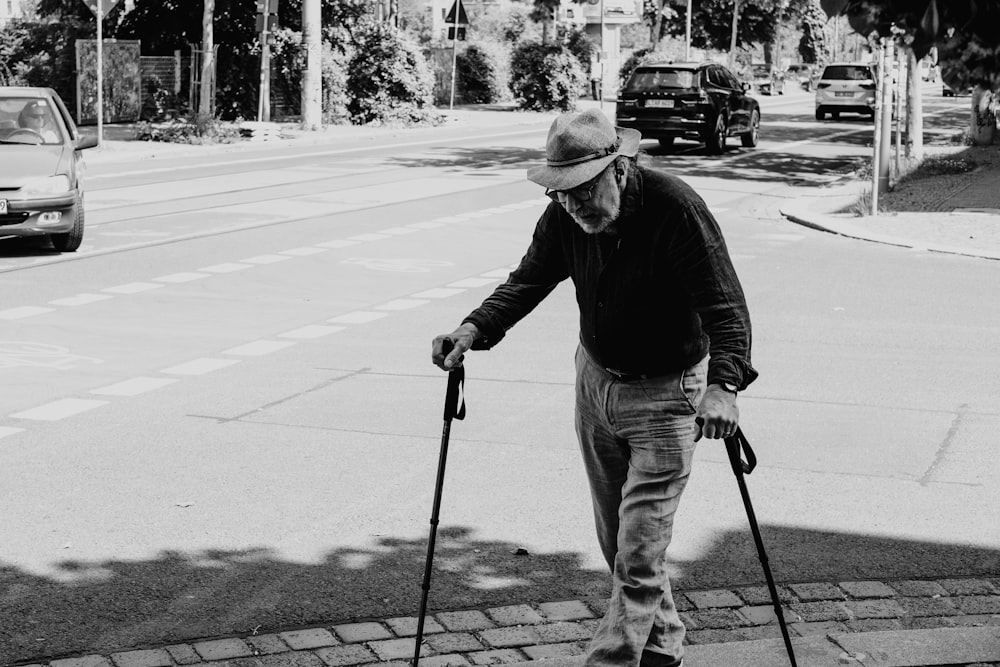目次
脳卒中片麻痺例に対する安易な杖の導入は危険?
脳卒中片麻痺例に対して理学療法士・作業療法士が歩行補助具の選択をせまられることってけっこう多いと思います.
脳卒中片麻痺例の場合には杖歩行の獲得が目標となることが多いわけですが,ここで問題になるのが1本杖を選択するか4点杖を選択するかといった点です.
今回は脳卒中片麻痺例を対象として杖の使用が歩行速度に与える影響を調査したシステマティックレビューをご紹介させていただきます.

今回ご紹介する論文
Disabil Rehabil. 2020 Aug 28;1-8. doi: 10.1080/09638288.2020.1808088. Online ahead of print.
Canes may not improve spatiotemporal parameters of walking after stroke: a systematic review of cross-sectional within-group experimental studies
Patrick R Avelino 1, Lucas R Nascimento 1 2, Kênia K P Menezes 1, Louise Ada 3, Luci F Teixeira-Salmela 1
Affiliations expand
PMID: 32857674 DOI: 10.1080/09638288.2020.1808088
今回ご紹介する論文は2020年に掲載されたばかりの論文です.
研究の目的
Purpose: To examine whether using a cane would improve spatiotemporal parameters of walking, i.e., speed, stride length, cadence, and symmetry after stroke.
この研究では,脳卒中症例における杖を使用が,歩行の時空間的パラメータ,すなわち歩行速度,歩幅,ケイデンス,歩行の対称性に与える影響を明らかにすることを目的としております.
研究の方法
Material and methods: Searches were conducted in eight databases. The experimental condition was walking with a cane. Four outcomes were of interest: walking speed, stride length, cadence, and symmetry.
8つのデータベースを用いて検索を行っております.
取込(実験)条件は杖を使用した歩行として,歩行速度,歩幅,ケイデンス,歩行の対称性といった4つのアウトカムんちういて調査を行っております.
研究の結果
Results: Twelve studies were included. Results from nine studies suggested that individuals with stroke walked 0.01 m/s (SD 0.06) slower with a single-point cane, compared with no cane. Two studies suggested a reduction in cadence (MD-5 steps/min, SD2) and an increase in stride length (MD 0.08 m, SD 0.01). Three studies suggested that individuals walked 0.06 m/s (SD 0.07) slower with a four-point cane, compared with no cane. Four studies suggested that individuals walked 0.06 m/s (SD 0.04) faster with a single- point cane compared with a four-point cane. Results regarding other outcomes were inconclusive.
結果として12件の研究が解析対処つおなっております.
9件の研究の結果から,脳卒中症例の歩行速度は,1本杖を使用した場合に1本杖を使用しない場合と比較して0.01m/s(SD 0.06)遅くなることが明らかとなりました.
また2件の研究では,ケイデンスの低下(MD-5歩/分,SD2)と歩幅の増加(MD 0.08m、SD 0.01)も明らかとなりました.
さらに3件の研究では,4点杖を使用した場合には,杖を使用しない場合と比較して歩行速度が0.06m/s(SD 0.07)遅くなることが明らかとなりました.
加えて4件の研究では,4点杖と比較して1本杖の方が0.06m/s(SD 0.04)速く歩行できることが明らかとなりました.
研究の結論
Conclusions: Results showed no worthwhile improvements in spatiotemporal parameters of walking with a single-point cane and a slight reduction with a four-point cane, compared with no cane. Individuals walked slightly faster with a single-point cane compared with a four-point cane, but the evidence is insufficient to support this superiority.
1本杖を使用しても歩行の時空間パラメータに有益な,4点杖をしようしても杖を使用しない条件と比較してわずかに時空間パラメータに負の影響がみられました.
1本杖を使用した場合には,4点杖を使用した場合と比較して歩行速度がわずかに向上しておりますが,この変化を裏付ける証拠は不十分でありました.
リハビリテーションへの影響
IMPLICATIONS FOR REHABILITATION A single-point cane may not improve spatiotemporal parameters of walking after stroke. Walking with a four-point cane may slightly decrease spatiotemporal parameters of walking. Canes may be prescribed without the fear of negatively impairing walking kinematics.
1本杖は脳卒中後の歩行の時空間パラメータを改善しない可能性があります.
また4点杖を用いた歩行では歩行の時空間パラメータがわずかに低下する可能性があります.
今回は脳卒中片麻痺例を対象として杖の使用が歩行速度に与える影響を調査したシステマティックレビューをご紹介させていただきました.
これは解釈が非常に難しいですね.
確かに杖の使用によって歩行パラメータに負の影響が出現しておりますが,こういった歩行パラメータが低下するからこそ転倒しにくくなるというふうにも捉えられます.
ただ理学療法士・作業療法士の立場としては闇雲に杖の使用を勧めるのではなく,杖の使用が姿勢・動作の実用性(安定性・速度性・耐久性等)にどのように役立っているのかを常に考える必要があるでしょうね.







コメント